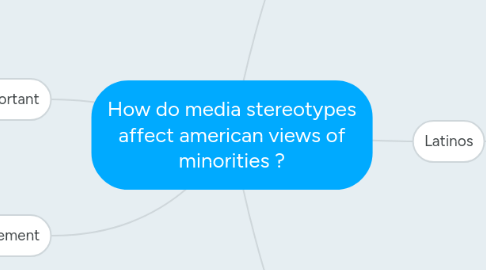How do media stereotypes affect american views of minorities ?
by Sahar Haimed

1. Muslims/Arabs
1.1. The predominantly negative media portrayal of Islam and Muslims needs to be balanced by widespread knowledge of peace-loving Muslims who pursue the path towards union of love and will with God.
1.2. This current obsession is tinged with negative signifiers with the global media’s predominantly negative portrayal of Islam and Muslims, depicting Muslims generally as violent, fanatical, bigoted, or as extremists and terrorists.
1.3. Dixon found that among those described as domestic terrorists on those programs, 81 percent were identifiable as Muslims. Yet in FBI reports for the same period, only 6 percent of domestic terrorist suspects were Muslim
1.4. n fact, terrorism on American soil is far more likely to be committed by white supremacists, Dixon says.
1.5. Most Americans form their opinions of other cultures or people based on what they read in print, hear on the radio, see in films, see on television, and see on the Internet. Since the majority of Americans obtain information from various media outlets, the mass media plays an important role in the development of a person’s opinions and worldview.
1.6. The portrayal of Arab Americans as victims will also increase following September 11, 2001. Since the events of 9/11, it has been documented that Arab Americans were victims of discrimination and hate crimes.
1.7. The two most typical Muslim stereotypes are the images of the Muslim-Arab, terrorist male and the oppressed, veiled Muslim woman.
1.8. In addition to legislative violations of civil liberties, Muslims face physical abuses and social discrimination.
2. Latinos
2.1. Latino-Americans, have been the objects of derision in popular media using the following prominent stereotypes: the comic (unintelligent, lazy buffoons), the Latin lover (oversexed, promiscuous seducers), and the crook (violent, law-breaking criminals).
3. Why this important
3.1. Media plays an influential role in shaping how we think about and enact race in our everyday lives.
3.2. Often used interchangeably, race is a way of classifying individuals and groups on the basis of physical characteristics, particularly one’s skin color.
3.3. Minority groups were evaluated more negatively than whites in general.
4. African American
4.1. African-Americans have been portrayed using such despicable stereotypes as the mammy (big, mean, loud mother figure), the coon (lazy, unreliable buffoon), the buck (savage, ruthless brute), and the tom (submissive, loyal slave)
4.2. More than half the survey respondents rated African Americans as less intelligent than whites.
4.3. Mass media have played and will continue to play a crucial role in the way white Americans perceive African-Americans.
4.4. The media have and will continue to portray a self-serving negative stereotype of the African-American community.
4.5. More importantly, these destructive images or lack thereof affect African American children exponentially, since African American children watch considerably more television than Caucasian children.
4.6. Shuey et al. reported that .6% of African Americans were in advertisements, 95.3 % of the time they were represented as unskilled laborers, entertainers or athletes.
4.7. The media only fueled the hatred that Americans felt towards all Arabs when it was relatively a small group of people responsible for these attacks.
4.8. Media in the U.S. does not report the facts about the war in Iraq. It does not tell us every side of the story because just like our history book it never has.
5. Thesis Statement
5.1. Because stereotypes in the media exaggerate cliched portrayals of minorities, the media promotes racism.


